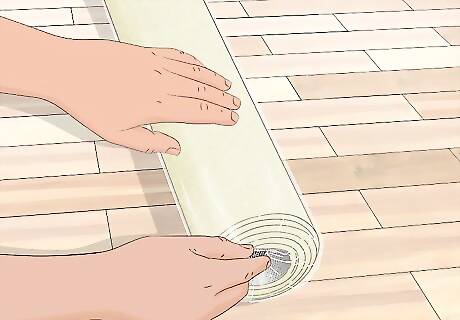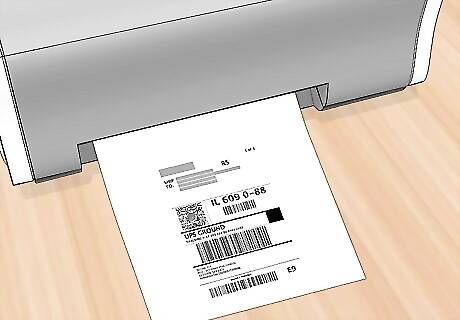
views
- Fold your rug into thirds if it’s over 8 by 10 feet (2.4 m × 3.0 m) to minimize the size of the box you’ll need for shipment. If your rug is smaller, skip to rolling it instead.
- Roll up your rug from top to bottom and tie a piece of string around the center to prevent it from unraveling.
- Cover your rug with plastic wrap before putting it in a shipment box to protect it from damage during transit.
- Amazon generally accepts returns within 30 days with proof of receipt. You may be eligible to ship your rug back to an Amazon facility or drop it off at a box-free return center.
Packaging Your Rug for Return

Make sure your rug is clean. If you’ve opened your rug to check if it works in your space but were unsatisfied, make sure it doesn’t have any particles or crumbs hanging around on it before you roll it up for return. You can vacuum it or simply lift it up and shake it out. Vacuuming your rug before you roll it up ensures the fibers stay neat and tidy. Be sure to Vacuum your rug on both sides for a spotless clean.

Find the grain direction of your rug. Run your hand across the surface of your rug. If it feels smooth to the touch, that is the direction of your rug’s grain. If you run your hand backward across your rug and the fibers lift, and it feels rougher, this is against your rug’s grain. Noting the direction of your rug’s grain is important because you’ll want to fold it against its grain to protect it in the next step.

Fold your rug into thirds against the grain if it's 8 by 10 feet (2.4 m × 3.0 m) or larger. Turn your rug around (pile side down) so the back faces upwards. Grab one end of the rug and fold until it's 1/3 of the way toward the middle, then grab the other end and fold it over the other side. Finish by folding the rug in half. If your rug is under 8 by 10 feet (2.4 m × 3.0 m), you can skip this step and go straight to rolling it up instead. Folding helps minimize the amount of space your rug will take up, allowing you to use a smaller box for shipment.

Roll up your rug against the grain. Take one end of your rug and tightly roll it upwards from bottom to top. It’s best to roll your rug against the grain, if possible, so the fibers don’t get misshapen and kinked. Remember to roll up your rug slowly and adjust if necessary so that your end result is a tight, evenly-rolled cylinder. It might take multiple tries to get your rug rolled right, as it’s easy for the cylindrical shape to become uneven or loose throughout the rolling process. Ask a friend to help you roll up your rug to make it easier.

Tie the middle of your rug roll with string to hold it together. Using string or twine, tie the center of your rug roll, so it doesn’t unravel. Make sure your knot isn’t too tight, as to dent the rug, but just tight enough so that your roll doesn’t become loose. For extra hold, you can also tie twine or string around the top and bottom of your rug roll.

Cover your rug with plastic wrap. You can use contractor bags (heavy-duty garbage bags), polyurethane rug wrap, or the plastic casing it came with if you still have it. The important thing here is that your rug is wrapped with some sort of protective coating before you place it in a box. Covering your rug with plastic wrapping keeps your rug safe during shipping, as sometimes cardboard shipping boxes can become wet, break down, or even rip open in transit. We want to ensure you get the refund you deserve by avoiding any possible damage to your rug. Be sure to ship out your rug soon after you’ve wrapped it. Plastic wrap can cause your rug to collect moisture and potentially cause mildew, so storing it for extended periods while it’s in plastic isn’t a good idea, but it’s fine if it’s only for a short period to keep it safe during transit. Make sure your plastic wrapping covers the entirety of your rug roll. You can use tape over the plastic at the top and bottom of the roll to ensure your rug stays covered throughout transit.

Choose a box for shipment. Pick a shipping container that suits your needs based on the measurements of your rug you took. Most people prefer to ship their items in cardboard shipping boxes which can be easily found at postal stores or online. Whatever you choose, just make sure to pick a box big enough to fit your rug without having to squeeze it in, as you don’t want your rug to get dented and damaged during the transit process. Using a measuring tape, measure the length, width, and height of your rolled-up rug to determine the size of box you’ll need for shipment. Write these numbers down on a piece of paper or on your phone so you don’t forget them. You can also use the box your rug came in if you still have it and it’s in good condition. A tightly-packed rug may become ineligible for a refund if the condition is deemed too damaged by a 3rd-party seller.
Returning Your Rug to Amazon

Check if your rug is eligible for return. Go to your orders page and click the item you want to return. In the return tab, you can check if your rug is eligible for return and see what unique options are available to you and your item. Amazon generally accepts lightly used, opened returns within 30 days of purchase, though this can vary depending on whether your rug was purchased through Amazon or a 3rd party seller. In the case of 3rd party sellers, some charges and fees may be associated with returning your rug. Usually, these fees will come out of your refund return, but this can vary from seller to seller.

Choose your preferred return method. Amazon accepts returns in a variety of different ways, including packaging and dropping them off at your local post office or simply taking them to an easy drop-off location that requires no packaging at all. Amazon’s label-free, box-free return locations include Amazon Hub Counters, select Whole Foods, select UPS stores, and select Kohls, depending on your area. If you’re ineligible for a label-free, box-free return, you’ll have to print out a label, package, and ship your return through UPS or your local postal service location. If you choose to bring your rug to a box-free, label-free Amazon return location, there’s no need to package your rug at all. Simply roll it up and be ready to show your return QR code.

Print or download your return label. Depending on your chosen return method, you’ll need to print or download your Amazon return label. If you’ve chosen to package and return your rug, print out your return label and secure it on the front of your shipping box with clear packing tape. If you’ve opted for a label-free, box-free return, take a screenshot of your QR code and be prepared to show it at your nearest Amazon return location during drop-off.

Drop off your rug at the post office or a return center. Now that you’ve done all the work, it’s time to drop off your rug return to an Amazon return location, UPS, or alternative postal service. Make sure your return label is clearly displayed on the front of your box, or have your return QR code ready to show the return worker and let them take care of the rest. Great job! Now you can rest easy and await your refund, which is typically processed in around 3-5 days but can take up to 30. You can track the status of your return by going to the Orders tab, clicking on the relevant item, then clicking “View Return/Refund Status” next to your item.


















Comments
0 comment